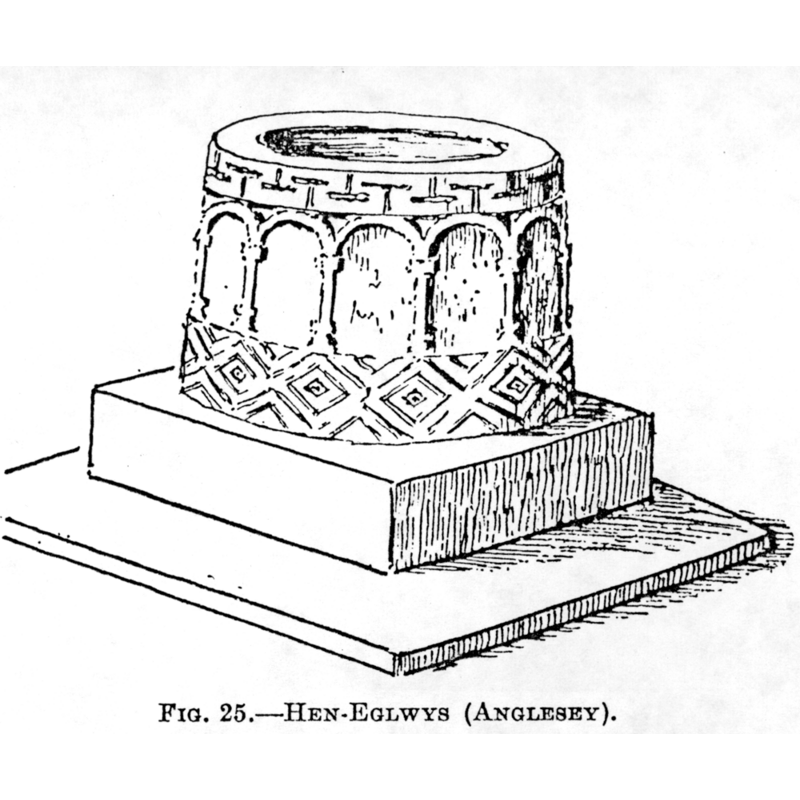Heneglwys / Hêneglwys / Hen-Eglwys / Hên-Eglwys

Image copyright © [in the public domain]
PD
Results: 6 records
B01: design element - architectural - arcade - blind - round arches
BBL01: design element - patterns - diamond or lozenge
BBU01: design element - patterns - fretwork
view of font
view of font
INFORMATION
FontID: 09116HEN
Object Type: Baptismal Font1
Church/Chapel: Parish Church of St. Llwydian
Church Patron Saints: St. Llwydian
Country Name: Wales
Location: Anglesey, Gwynedd
Directions to Site: Located just S of Bodffordd and N from the A5, across from Cerrigceinwen, 8-10 km W of Bangor
Font Location in Church: Inside the church
Century and Period: 10th - 11th century / 12th century (early?), Pre-Conquest? / Norman?
Cognate Fonts: The fonts at Penmon [No. 1] and Llanbeulan; also the font at Llaniestyn [cf. FontNotes]
Font Notes:
Click to view
Lewis' Dictionary edition of 1849 remarks that when this church was rebuilt in 1845, care was taken to preseve and replace the old baptismal font. Described and illustrated in Tyrrell-Green (1928) as a tub-shaped font from the Norman period; the cylindrical basin is ornamented with a blind arcade of round arches in the middle, between a band of key pattern at the top and another of chevron/concentric lozenge pattern at the bottom; it is mounted on two square blocks as lower base or plinth. Described and illustrated by Peter Lord, in Diwylliant... (1998-2003): cylindrical tub-shaped baptismal font of the late 10th or early 11th century, and suggests that they may be the work of the same maker responsible for the fonts at Penmon No. 1 [recycled foot of cross?] and Llanbeulan; the ornamental themes appear related to the font at Llaniestyn also in this area, farther south, on the Lleyn Peninsula [Lord (ibid.) mentions "a very similar vocabulary of images"]. Unlike these two, however, the Heneglwys font is perfectly cylindrical; the sides are decorated with a band of "T-fret" around the upper side, and a band of diamond motifs around the lower side, whereas the main central area of the basin sides is taken by a very regular blind arcade of round arches. The font is now raised on a polygonal (octagonal?) plinth.Thurlby (2006) points out "the detailing of the arches of the arcade in which the sculptor creates a subtly curved roll moulding and a hollow between the extrados of the arch and the curved triangles in the spandrels. The juxtaposition of roll and hollow is very much in the repertoire of the Romanesque architect and its appearance on the font is most readily explained if we see the font and heads at Heneglwys as products of the same time and patron", which Thurlby links to Gruffudd ap Cynan, ruler of Gwynedd [b. 1054/1055 -- d. 1137] and therefore suggests a date for this font probably in the early part of the 12th century.
MEDIUM AND MEASUREMENTS
Material: stone
Number of Pieces: one
Font Shape: tub-shaped (round)
Basin Interior Shape: round
Basin Exterior Shape: round
LID INFORMATION
Material: wood
Notes: with an octagonal base
REFERENCES
The Visual Culture of Wales = Diwylliant gweledol Cymru, Cardiff: University of Wales Press, 1998-2003
Lewis, Samuel, A Topographical Dictionary of England, Comprising the Several Counties, Cities, Boroughs, Corporate and Market Towns, Parishes, Chapelries, and Townships, and the Islands of Guernsy, Jersey, and Man, with Historical and Statistical Descriptions [...], London: S. Lewis, 1831
Thurlby, Malcolm, Romanesque architecture and sculpture in Wales, Little Logaston, Woonton, Almeley, Herts.: Logaston Press, 2006
Tyrrell-Green, E., Baptismal Fonts Classified and Illustrated, London: Society for Promoting Christian Knowledge: The Macmillan Co., 1928
